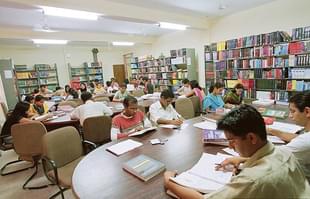Economy
The State Of Higher Education In India
Swarajya Staff
May 17, 2018, 05:02 PM | Updated 05:02 PM IST
Save & read from anywhere!
Bookmark stories for easy access on any device or the Swarajya app.


The Human Resource Development (HRD) Ministry released the All India Survey On Higher Education (AISHE) for 2016-17 on 5 January 2018. The aim of AISHE is to create a comprehensive database that describes the state of higher education in the country without time lags. It details reliable education ratios such as gross enrollment ratio, pupil-teacher ratio and so on, and tells us about teaching and non-teaching positions in the higher education space as well as infrastructure capacity with various institutions.
The AISHE data is collected with the help of thousands of higher educational institutions across the country where nodal officers upload the required information on an online portal in a standardised format. For the 2016-17 survey, the data on profile of teachers was also collected, which fetched details of 12.68 lakh teachers – an exercise that will prove useful in ascertaining the quality of faculties in colleges and universities.
Some of the major findings in the survey are encouraging. Total enrollment in higher education stood at 35.7 million in 2016-17, up from 30 million in 2012-13. Of these, around 80 per cent of the students are enrolled in graduate courses. The gross enrollment ratio (GER) calculated for the 18-23-year age group increased from 19.4 per cent in 2010-11 to 25.2 per cent in 2016-17. While we have certainly improved, it’s still a long way away from the ideal scenario. The GER for China is over 43. For the United States, it is over 85. This shows the long journey that lies ahead of us on this front.
Another interesting finding is about college density, which tells us about the number of colleges per lakh eligible population (18-23-year age group). At the all-India level, the data is impressive. There are 28 colleges per 100,000 eligible students, translating into a college for every 3,500 students. But some of the states, especially in the eastern part of the country, are way behind. College density is poorest in Bihar (7), Jharkhand (8) and West Bengal (11). What’s worse is that the situation hasn’t improved in the past five years.
Bengaluru district tops the country in college density with 1,025 colleges in the area, followed by Jaipur, Hyderabad and Pune as shown in the table.
The enrollment of foreign students in Indian universities is also picking up pace, but most of them are from neighbouring countries, especially Nepal, Afghanistan, and Bhutan.
An overwhelming majority of the colleges (77.8 per cent) in the country are privately managed – 64.2 per cent unaided and the rest 13.6 per cent on state aid.
Around 80 per cent of the colleges have less than 1,000 students enrolled in them, which shows that a majority of the higher educational institutions are small-scale operations.
While the popular perception today is that most of the students are entering science, technology, engineering and medical (STEM) fields, the truth is that the maximum number of students (38 per cent) at the graduate level are enrolled in the arts/humanities/social sciences. Only 16.7 per cent of the students are enrolled in science courses, followed by engineering and technology (14.7 per cent) and commerce (14.1 per cent).
Only the 10 top courses cater to 84 per cent of the college-going population. The Bachelor of Arts (BA) degree was awarded to the maximum number of students (21.69 lakh), followed by Bachelor of Science (10.2 lakh), Bachelor of Commerce (9.48 lakh), Bachelor of Education (4.39 lakh) and Bachelor of Technology (4.46 lakh). Only 35,451 students got the ‘Bachelor of Medicine, Bachelor of Surgery’ (MBBS) degree. At the postgraduate level, 5.66 lakh students got awarded the Master of Arts, followed by Master of Science (2.36 lakh), Master of Business Administration (1.98 lakh) and Master of Technology (76,694).
Given below are enrollment figures for important disciplines in graduate and postgraduate programmes.
The unmissable trend becoming clear from the tables is that the craze for the engineering degree is thankfully on the wane as many are struggling to find jobs after earning their degrees. In the last three years, as many as three lakh less students are taking to engineering degrees. The good news is that there is a steady improvement in the number of students enrolling in medical courses. We need more doctors and less engineers.
Overall, it seems from this survey, which shows impressive strides on enrollment, college density and pupil-teacher ratio, that we have finally managed to fix the supply problem. Now, we need to focus on the quality.





